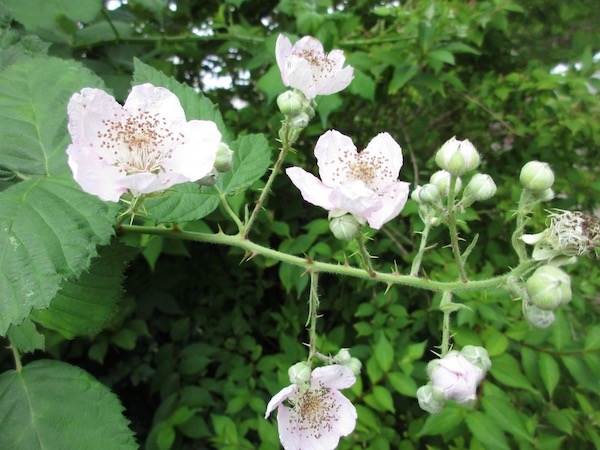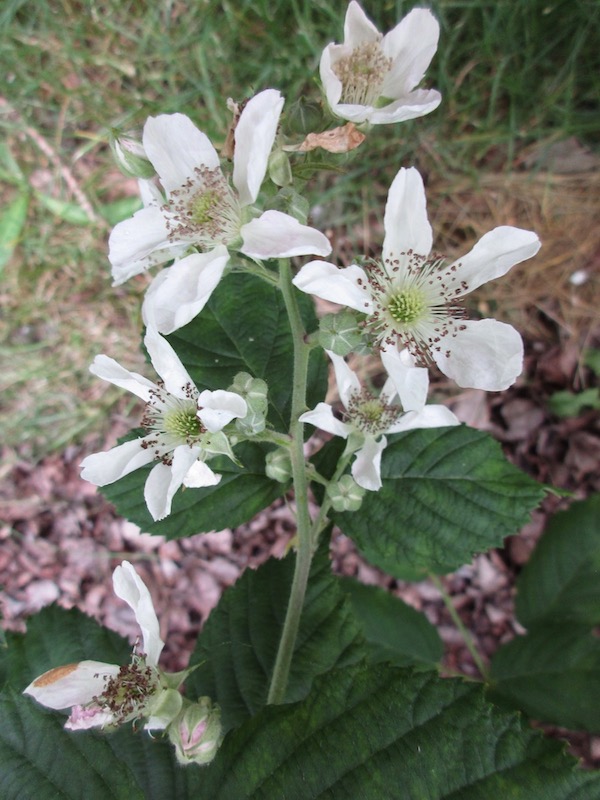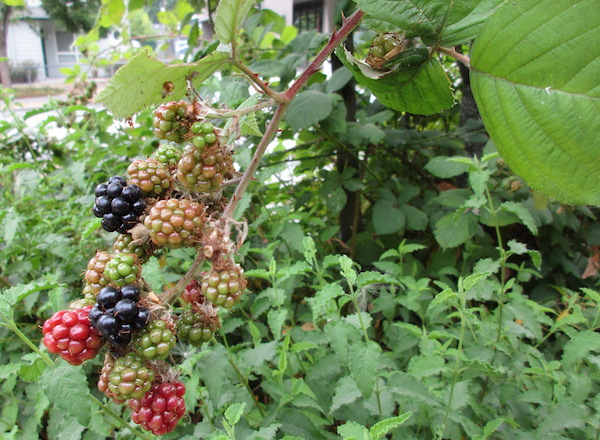| Among Seattle's wild edible plants, most familiar is Himalaya Blackberry. That is why a 1991 local foraging guidebook was titled Beyond Blackberries. Himalaya Blackberry covers more acres in Seattle than any other naturalized or weedy plant species. It grows from cattail marshes and willow swamps to dry sandy bluffs. Its seedlings spring up virtually everywhere. Everyone knows it. |
Its common name dates from about 1885, when the world's greatest plant breeder, Luther Burbank, of California, introduced "Himalaya Giant." Burbank had obtained his original seed from an English traveler who stated that they had been gathered high up on the Himalaya Mountains. Depending on the printed sources checked, there are inconsistencies and conflicting dates cited as to the plant's early origin. At the very latest, it was being distributed by 1895. Over the many decades since then, this plant has gained fame, and has been called by botanists by a confusing, exasperating, and changing array of at least 7 scientific names:
|
| Rubus armeniacus Focke; of the Caucasus |
| Rubus bifrons Vest; of Europe |
| Rubus discolor Wh. & Nees (a synonym of Rubus ulmifolius Schott; of Europe, N Africa & W Asia) |
| Rubus fruticosus L.; of Europe |
| Rubus præcox Bertol.; of Europe |
| Rubus procerus P.J. Müll. ex Boulay; of Europe |
Rubus thyrsanthus Focke (a synonym of Rubus Grabowskii Weihe ex Günther, Grab. & Wimm.; of Europe)
|
| Last year, I learned that in 2017, Marcel Rejmánek, a scientist at Davis, California, had published Rubus præcox: a newly recognized invasive blackberry in California. Rejmánek explained that at least two Rubus species have been called Himalaya Blackberry. |
| In Seattle, certainly at least two "Himalaya Blackberry" species and possibly three can be found. I have not the leisure currently to learn to tell them apart, and discover their relative abundance in Seattle. They vary in details, but I do not know about their overall aspect, vigor, yield, and so forth. |
| Based solely on the fact that the seeds were claimed to be from the Himalaya, the Caucasian species Rubus armeniacus appears to have the strongest claim to be the original Himalaya Blackberry than the other species cited --all Europeans. Armenia is closer to the Himalayas. However, unless someone examines enough early herbarium collections, and identifies them carefully, the matter remains unresolved. Thus, with our current understanding, the common name Himalaya Blackberry must be considered to apply nowadays to more than one species found wild on the Pacific Coast. |
| Below, I reproduce a Himalaya Blackberry advertisement from about 1910, and photos that I took this month of Himalaya Blackberry flower clusters in Seattle. Look close: the prickles on the armeniacus are mostly straight, whereas mostly curved on the præcox. Also the præcox flower petals average a tad bit smaller, and are paler. And the præcox flower stamens are shorter. |
| You might rightly exclaim, "Big deal! Who cares?" A lumper taxonomist would make one species out of such similar species. When the botanist Antonio Bertoloni described Rubus præcox in 1842, he mentioned the Italians called it Rovo Primaticcio (Early Bramble), saying it flowered in May and early June before the common Italian blackberry. Perhaps we should call Rubus armeniacus the Original Himalaya Blackberry, and Rubus præcox the Early Himalaya Blackberry. If we verify that Rubus armeniacus is more common, then it can be called the Common Himalaya Blackberry. |
To me, it is exciting that a brand new species we never expected has been reported right under our noses. It will be interesting to observe, over years, if its flowers bloom earlier or later, its berries ripen earlier or later, and various other differences. And, if other extremely similar Rubus species also grow here, passing under the name Himalaya Blackberry.
Back |

Rubus armeniacus flowers; photo by ALJ
|

Rubus armeniacus flowers; photo by ALJ
|

Himalaya Blackberry 1910 ad
|

Rubus præcox flowers; photo by ALJ
|

Rubus præcox flowers; photo by ALJ
|

Rubus præcox berries; photo by ALJ
|

